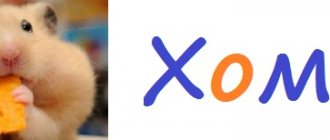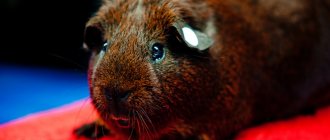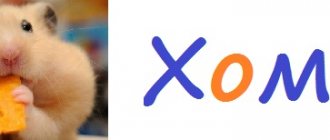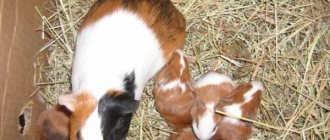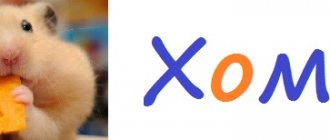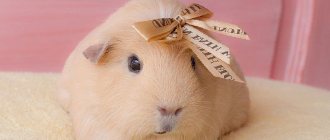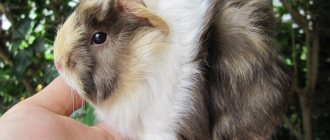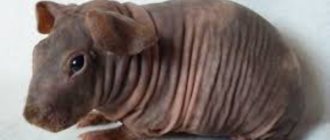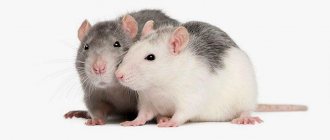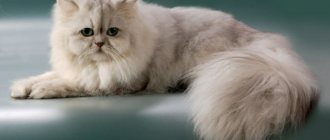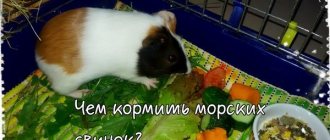- home
- Guinea pig
- Guinea pig breeds
02/14/2019 Among the breeds of guinea pigs, smooth-haired varieties are the most popular. This is due to the simple care of such animals, which even children can do. The common breeds of rodents belonging to the smooth-haired species, as well as the peculiarities of keeping these pets, will be discussed below.
Description of the guinea pig breed "Simple Smooth"
The Plain Smooth is the most common breed of guinea pig. These are the guinea pigs that can most often be found in pet stores. They have short, shiny fur, smooth, without rosettes. The color can be any: single color or a combination of different colors.
This is an extremely popular breed and so widespread throughout the world that very often such pigs are called “ordinary” or even “mongrel”. You can also find the name “simple guinea pig”. Meanwhile, in the West (especially in the USA), pigs of this breed are called American Guinea Pig, and it is under this name that the breed is one of the officially recognized breeds in English-speaking countries and in Europe. Therefore, keep in mind that you can safely put an equal sign between our “simple smooth-haired” and “American” guinea pigs.
In fact, it can be said that the simple smooth-haired guinea pig is the breed that symbolizes all guinea pigs to the general public.
If you, without properly understanding the breeds of guinea pigs, want to buy yourself this cute and affectionate pet, then in 90% of cases you will become the owner of a pig of this particular breed, since the vast majority of pet stores sell just such pigs, because they are easy to buy. content and very unpretentious.
Source
Skinny
These pigs of truly exotic appearance appeared as a result of a mutation in 1978 at the Institute of Montreal (Canada). They have no fur, only on the nose and paws there are sparse curly and coarse hairs. Skinny skin is very soft and velvety. The most common color is chocolate; there are black, tortoiseshell, silver, lilac, etc.
Skinnies have an excellent appetite, which is not surprising: they have a faster metabolism, as they need to retain body heat. Therefore, they eat 3 times more than their furry counterparts, sometimes gnawing on something all day long.
Due to their lack of fur, skinnies require a little more care and attention than regular guinea pigs. The main thing that future owners of these cute and gentle creatures need to know is that skinnies need to be protected from drafts and always kept warm. If fasting days are only beneficial for most animals, then for skinnies to remain for two days without food is literally like death. At the same time, skinnies are prone to obesity, so the owner’s task is to carefully consider the diet, establish a diet and strictly adhere to it.
Baldwins
Unlike Skinnies, who have tufts of hair on their paws and nose, Baldwins are a completely hairless breed. Babies are born covered with fur, like ordinary pigs, but by the age of one month it completely falls out. Baldwins have extremely delicate skin; both cold and direct sunlight are dangerous for it.
A person who has decided to get a guinea pig and has become acquainted with all the variety of breeds faces a difficult question: how to choose “your breed” among all this diversity?
Surely, many people want to have a rare breed of pig at home. Thus, hairless guinea pigs are very in demand and popular today. But here you need to take into account that these are more delicate and sensitive animals, they are more demanding in terms of care and living conditions. And the price for such exotics will be significantly higher than for pigs of less rare breeds. In addition, when purchasing a pig of a rare breed with a good pedigree, additional responsibility is imposed on the owner: you need to join a club, take part in exhibitions, find your pet the most suitable partner for mating, etc.
Pigs of less rare breeds can be no less beautiful and affectionate pets. Short-haired guinea pigs are easier to care for, they have high immunity, which means they get sick much less often than other breeds of pigs. Animals with short hair are the best choice for a novice breeder. In addition, if you are purchasing a guinea pig for a child, it is best to choose just such a pet. Caring for rosette pigs is also not very difficult, but they are somewhat more expensive. As for guinea pigs of long-haired breeds, they need more thorough coat care, which will require much more time.
general description
The body of an adult pet is round, stocky, no more than thirty centimeters. There are four fingers on the forelimbs, and only three on the hind limbs. The shoulders are wide, the head is heavy and large. The ears are located at a great distance from each other, the nose is hooked and very thick, bulging eyes are black. The weight of the animal is about 1000 grams. The coat is shiny, consisting of silky hairs, fits tightly to the body, its length is no more than three centimeters, which is considered a distinctive feature. The fur is directed in one direction over the entire surface and creates a semblance of a glossy cover. Some rodents have rosettes on the back of their necks. Color - three-, two- or one-color.
Owner reviews
Breeders of pigs with chic hairstyles say that these animals require careful care. Their character is also called difficult. They are picky eaters and have a hard time with hygiene procedures.
Rodents are quite voracious. If there is no garden, feeding a pet will cost about 4,000 rubles. Additionally, you need to visit a veterinarian.
Breeders warn that long-haired pets shed all year round. This means that hair from the animal will need to be removed regularly, or it will be everywhere.
Breeds of smooth-haired guinea pigs
Scientists have managed to breed several interesting breeds of these animals, which have some characteristics:
- American Teddy - rodents look very similar to teddy bears, which is why they were given this name. They are quite large, but their physique is proportional. The head and nose are round in shape, the ears are hanging. The wool is thick.
- Rex are powerful and muscular rodents. A distinctive feature is drooping ears. Short and curly hair stands on end. Color, combining several shades or having one, creates a unique color.
- Satin - smooth-haired guinea pig has a slightly elongated muzzle, ears pressed to the head. Their color, like that of the paw pads, is the same as the general color. It comes in all shades of red, and there are also black and white versions. The wool, due to its special structure, is shiny. The hairs are hollow inside. This breed has several subspecies - tortoiseshell, spotted and agouti.
- Self are very large individuals. They have a glossy and straight coat. Its peculiarity is its monochromatic color (red, brown, black, beige, red-orange), the absence of curls and rosettes. The pads of the paws and the color of the ears are golden or pale pink. Eyes red or black.
- Crested - body length reaches 35 cm, and body weight reaches one and a half kilograms. The peculiarity of this breed is the presence of a flat rosette on the head. There are two subspecies - American, which always has a white rosette, regardless of the color of the coat as a whole, and English, which has a rosette of the same color as the color of the animal. The shades are quite varied; there are smooth-haired guinea pigs - black, smoky, golden, white or two-colored.
Rex
A characteristic feature of this variety of short-haired guinea pigs: thick, curly and very dense hair, the length of which is 17 mm. The wool stands vertically, without tilting or bending. The muzzle is decorated with winding mustaches.
This variety was first described at the beginning of the 20th century, but was formed as a breed much later. The entire rex population came from one litter of curly-haired guinea pigs born in 1975.
Disadvantages: long hair (longer than 2 cm), “breaks” along the spine, elongated body, light bones, straight mustache, damp lower eyelid.
In the photo: Rex guinea pig
Cell
Smooth-haired guinea pigs do not require special care, but they need their own cage, which has an area for eating, resting, playing, and also a toilet. The best design for these purposes is a design with a plastic tray into which a special filler is poured, and dimensions per individual - 80 x 90 cm and a height of about 35-50 cm. Bedding, two feeders, a tray, a drinking bowl, and toys are placed in the cage , stones for sharpening claws, shelves, ladders, and also hay. Pigs feel good at temperatures from 18 to 20 degrees.
Every day you need to remove leftover food and wash the feeder. The litter is changed at least twice a week. All surfaces of objects and the cage itself are treated monthly.
Lifespan
On average, pig-like rodents live about 5 years. With good care, the pet enjoys a life of 6 to 8 years. Sometimes especially lucky pigs live up to 10 years.
The short life expectancy is compensated by incredible fertility. 15 hours after giving birth, the female is ready to mate again as she goes into estrus. The offspring usually consists of 9 or 10 individuals. Thus, one individual can bring up to 100 babies per year.
Frequent births are not good for the animal, so it is better not to allow the female to give birth more than 2 times a year.
Nutrition
The diet of these rodents must include wheat bran, fresh, slightly dried greens, and cereal porridge. In winter, various special vitamin and mineral supplements, fruits, vegetables and dry herbs are added. They are given small wooden blocks or tree branches to grind down their teeth. It is allowed to periodically feed them with ascorbic acid, chalk and bone meal. They drink little liquid, but they need fresh water. Pigs are fed no more than twice a day. Special cereal sticks with honey can be given twice a week as a treat.
Smooth-haired guinea pigs should absolutely not be given any dairy products, eggs, meat, fish, spicy vegetables and cabbage, as well as smoked and fried ready-made meals. A balanced menu will allow your beloved pet to be healthy.
Water treatments
They are necessary in rare cases when the pig is very dirty. The rest of the time she cleans her fur on her own. For water procedures you need to prepare:
- small terry towel;
- special shampoo;
- container with anti-slip coating.
The water temperature should not exceed 38 degrees. During this manipulation, you must carefully ensure that water does not get into the animal’s ears. After completing the bath, he is wrapped in a towel.
Cleaning ears and eyes
This is an important step in caring for a smooth-haired guinea pig. Clean them regularly using a regular cotton swab, which must be moistened in an aqueous solution of Chlorhexidine. If there are crusts in the ears, a special “Bars” solution is instilled into them. If the animal squeals when performing this manipulation, then it is advisable to visit a veterinarian, since the cause of this behavior may be ear mites.
Crusts periodically form in the corners of the eyes; they can be easily removed with a cotton pad moistened with warm water or tea leaves. If you notice redness or watery eyes, then most likely a foreign body has entered the eye. In such cases, the help of a veterinarian is required.
Buying an animal
Before buying a guinea pig, you need to prepare a home for it. The cage should not be small, at least 50 square cm for each animal.
Cage without a roof
The bottom must be lined with a mixture of sawdust and wood filler, food must be placed only in a bowl, and there are different bowls for different foods, and a sippy cup with fresh water is a must. So that the animal does not get bored and has somewhere to hide, it is advisable to equip the cage with ladders, ropes, labyrinths, houses and caves. Whatever you have enough imagination and space for.
Cub choice
You can buy it either at the nearest pet store or at a nursery from professional breeders. The second option is more preferable:
- Guaranteed proper care for babies and their parents;
- They will show you the baby’s parents and tell you about the habits that are passed on to their offspring;
- They will explain about care, what can and cannot be done, and answer all questions;
- They will write a pedigree.
Grown-up guinea pig babies
The choice of a baby must comply with the rules:
- Age - at least 1 month, from now on they do not need breast milk;
- Healthy appearance - shiny coat, bright clear eyes, clean nose and ears;
- The pig should be active, nimble, and well-fed.
- Find out what kind of food she was introduced to, and switch to your food gradually, over the course of a week. Don't forget to change the water daily.
Their price is low, up to 4000 rubles.
Skin care and manicure
The smooth-haired guinea pig, a photo of which is in the article, requires brushing its coat every three to four days. A brush with soft natural bristles is suitable for these purposes. With this simple procedure, dead hair is removed and new hair growth is activated. Brushing is a pleasure for your pet.
Long claws cause a lot of trouble, as they cause bacterial infections and problems with the musculoskeletal system. They are cut with a special tool once every six months. This must be done very carefully so as not to damage the vessels and nerves that are located at the base of the claw.
Pigs are colorful
Smooth-haired tri-colored guinea pigs have soft, smooth, silky hair, without curls or rosettes. They are characterized by a bright, unusual pattern. The colors, and there are three of them in any shade, with the exception of white, black and bright red, are distributed in the form of a chessboard consisting of squares of the same size. The best specimens have two colors on the head and three or more patches of all colors on each side. In animals, the so-called dividing line is clearly visible, which is formed at the junction of areas located on the sides and runs along the entire body, both below and above. There is no specific color sequence, but purity of color is important. There should be no admixture of hairs of other shades. They have a short and wide head, eyes located far apart, clear and protruding, large ears hanging down.
Smooth-haired guinea pigs
All smooth-haired breeds of animals are united by common external characteristics. The coat of these pigs is thick and slightly glossy. The hairs are short and quite hard.
Smooth-haired pigs were used by breeders to develop new breeds of rodents. This process is not as simple as it may seem. For example, it is worth noting that when crossing curly-haired and smooth-haired guinea pigs, slightly more of the former are born than the latter. Another important nuance is that even a pair of smooth-haired pigs may produce offspring that are not smooth-haired. If smooth hair is not written into the genetic code of the parents as a dominant gene, then the probability of having smooth-haired guinea pigs in such parents is only one in five.
To understand the similarities and differences between smooth-haired pigs, it is worth considering the most popular breeds of these animals.
American Teddy
The American Teddy pig breed is quite large in size. The average weight of the animal is 1 kg. The rodent's body is tightly built, muscular, with correct proportions.
Teddy pigs are lop-eared. The muzzle is quite flat, the nose is round, the beady eyes are also round, and the cheeks are plump. The animal's coat is characterized by thickness and softness. The hairs grow perpendicular to the animal's body, so it seems that they stand on end. This feature of fur growth makes the rodent look like a plush toy.
The color of Teddy's fur coat can be one-color, as well as two- and three-color. The color is usually dominated by red, light and dark shades.
Crested
The Crested pig is large in size. The length of the body reaches 35 cm, and weight – up to 1.5 kg. A characteristic difference between the animals of this breed and others is the woolen rosette on the forehead. The hairs of the rosette are arranged horizontally, as if they were crushed.
Animals of this breed are conventionally divided into English and American. Their main difference from each other is in color - the first ones are completely monochromatic. The latter are found in one or two colors, but always with a light rosette (regardless of the color).
Rex pigs have well-developed muscles and straight posture. The length of the body reaches 35 cm.
The skeleton of the animals is broad-boned, the head is set, as they say, proudly. The rounded ears of Rex are larger in size than those of their relatives of other breeds. The distinctive features of the breed also include the fur characteristic of these rodents. The hairs are slightly curly and erect. This creates a slightly tousled effect. There are animals with both plain coats and interesting color combinations.
Selfies have a large head with large drooping ears that resemble rose petals. The length of the pigs reaches up to 32 cm, and the weight – up to 1.8 kg.
Thoroughbred selfies have only a single color and only smooth, even fur. The presence of impurities in the color is considered a defect, as is the presence of partings or rosettes in the fur coat.
Self pigs come in the following colors:
Ears and paw pads can be pink or golden. The eyes are usually black, but red ones are also found.
Periods of growing up
Conventionally, the life of a pig can be divided into 4 stages. The norms for weight and size may differ for different breeds, but for the dynamics of development they are common to all representatives of the species.
- childhood - 0-3 months;
- youth - 3 months - 1.5 years;
- maturity - 1.5 - 5.5 years;
- old age from 6 years.
The childhood period is characterized by intensive growth. The average weight of a newborn cavia is 50-140 g. The parameters are influenced by the age of the mother, living conditions during pregnancy, and the number of cubs in the litter. Usually the larger animals are those that were born first in the litter.
Baby guinea pigs are born quite large with fur and already with open eyes
How much a particular pig should weigh at 2 weeks can be determined by doubling its weight on the first day.
By the fifth week, the guinea pig's growth reaches 19 centimeters. Age is good for purchasing a pet. By this time, the animals are completely ready to be weaned from their mother.
Girls reach puberty around the 30th day of life, boys around the 70th day. Animals show interest in individuals of the opposite sex and are physically capable of reproducing. The rodent's body is still not fully formed, so mating at such an early age is not recommended.
In adolescence, the animal begins to show interest in the opposite sex. At 3 months, the difference in size between rodents of different sexes becomes clearly pronounced. The weight can exceed that of a newborn piglet by 10 times.
The formation of the body ends by the 6th month. The animal is ready to perform its reproductive function. The growth rate is decreasing.
The rodent becomes an adult at 15 months. Until these years are reached, kavias grow and gain mass. An adult guinea pig should weigh at least 700 g.
The average life expectancy of a pig is 6-8 years. From the age of 4, age-related changes begin in the body. By the age of 6, your guinea pig may begin to lose weight. Reproductive function is disrupted, problems with the absorption of nutrients appear. Aging affects appearance, coat and mobility.
Keeping smooth-haired guinea pigs at home
The main requirement is to provide the animal with comfortable housing. When arranging a house for a pet, it is important to divide it into special areas - play, dining, sleeping, restroom.
Cell
A cage with parameters of 80×90 cm and a height of 35 cm is suitable as housing for a pet. It is desirable to have a removable lid, as well as a plastic or glass retractable tray. The bottom of the cage is covered with a bedding of shavings or sawdust. Inside the pig's housing you need to place:
- shelter house for privacy and relaxation;
- toys, sports equipment and other equipment to entertain the animal (including tunnels, labyrinths, etc.);
- bowls for food and drink;
- hay field with soft dry grass;
- tray (pet litter can be bought at a pet store).
The cage is placed on a flat, reliable and stable surface - there should be no risk that the house will fall. In addition, the pet’s home should not be exposed to direct sunlight or drafts.
Caring for the animal and cleaning the cage
Rodents are characterized by cleanliness. They thoroughly clean their fur on a regular basis, but do not like to swim in water. You should arrange a bath day for your pet as rarely as possible - only if the animal smells bad.
They bathe the animal in water at a temperature of +24 °C and with a special shampoo from a pet store intended for guinea pigs. Other products are not suitable for the delicate skin of a rodent, so their use is fraught with irritation and damage to the animal’s skin.
During the washing process, it is important to ensure that water does not get into your pet’s ears. The bottom of the bath must first be lined with cloth so that the pig’s paws do not move apart.
The animal needs to be brushed regularly. To do this, you need a brush with soft bristles, preferably natural. Combing removes dead hair and gently massages the surface of the body, which promotes the growth of new hairs.
You cannot ignore such a procedure as cleaning your ears. You need to clean it carefully. To do this, use a cotton swab pre-soaked in chlorhexidine. If the animal reacts inadequately to the procedure - breaks out, squeals, etc., it must be shown to a veterinarian, and the sooner the better.
The animal's claws are trimmed with special nippers. This must be done carefully. The first time, it is better to cut the claws under the supervision of a professional.
As for cleaning the pet’s home, a schedule has been created for the stages of its implementation:
- Every day they wash the bowls and throw away the food that the animal has not eaten;
- change the litter three times a week;
- The cage is thoroughly cleaned monthly.
Features of the content of selfies
Nutrition
They can also be given special granulated food, but breeders recommend being careful with dry food. It causes obesity. Your guinea pig's diet should be well balanced throughout the year. During the summer months, it is recommended to dry and freeze nettles, alfalfa, dandelion leaves, clover, willow and birch twigs.
In addition to quality food, pigs need clean and fresh water. Many breeders pamper their pets with tomato juice and rosehip decoction. These drinks are not only tasty, but also very healthy.
Guinea pigs of the Self breed are not particularly demanding in terms of living conditions. A spacious cage measuring 35*65*40 cm with a house and feeders is enough for them. If the cage has a tray that extends out, this is more convenient for the breeder, as it makes it easier to clean and put away sawdust. The cage must be installed in a shaded place, away from heating devices and direct sunlight, and also in a place safe from drafts. All guinea pigs need movement and selfies are no exception. At least once a day they need to be given the opportunity to run around the apartment. The animals enjoy not only free movement, but also communication with the owner. Movement is also essential for good health. Animals that have constant walking do not have problems with digestion or breathing, and they are less likely to suffer from heart disease. In summer, animals can be taken for walks outside. To do this, use a special harness for guinea pigs. However, it is worth choosing good, dry, sunny weather and pre-treating the animal’s fur with special anti-parasitic drops.
Selfie beige color
Selfies are the ones most often bought as pets for children.
The animals are trainable, very playful, sociable and respond to their name. They do not show signs of aggression, do not bite and make contact with humans themselves.
Golden color of selfa guinea pig
Reproduction
Selfies are caring and very responsible parents. In large nurseries, a family of selfies is kept in a large cage, where the females collectively care for the offspring. Females not only help feed the cubs, but also take an active part in childbirth - they rupture the amniotic sac, lick and warm the newborn. However, Selfies are quite late-maturing guinea pigs.
Selfie pigs from the nursery
It is not recommended to cover the female earlier than one and a half to two years, until she is fully formed. Early mating will negatively affect the development and growth of the female, as well as the quality of the offspring. There is a risk of getting weak and stillborn cubs. There are also cases of death of a young female during childbirth.

